Crafting the perfect espresso at home has become an increasingly popular pursuit for coffee lovers. With a wide array of home espresso machines available, choosing the right one can be a daunting task. This guide aims to simplify that decision by highlighting some of the best home espresso machines currently on the market. From machines designed for beginners to those that cater to experienced baristas, this selection covers a range of preferences and budgets. Each machine is evaluated based on its features, ease of use, performance, and overall value, ensuring you find the perfect fit for your home brewing needs. Whether you’re looking to achieve café-quality espresso or simply enjoy a convenient and flavorful cup at home, this guide will help you navigate the options and make an informed choice.
- The Best Home Espresso Machines
- Final Thoughts
- What to Consider When Buying an Espresso Machine
- Frequently Asked Questions (FAQs) about Espresso Machines
- How Do You Maintain an Espresso Machine?
- What should I look for when buying an espresso machine?
- How do you clean an espresso machine?
- What are the differences between espresso, cappuccino, and latte?
- Are espresso machines worth the investment?
- What are the three main types of espresso machines?
- How long do espresso machines typically last?
- What accessories are essential for using an espresso machine?
- What are some common issues with espresso machines and how to troubleshoot them?
The Best Home Espresso Machines
Best Overall
Breville Barista Express
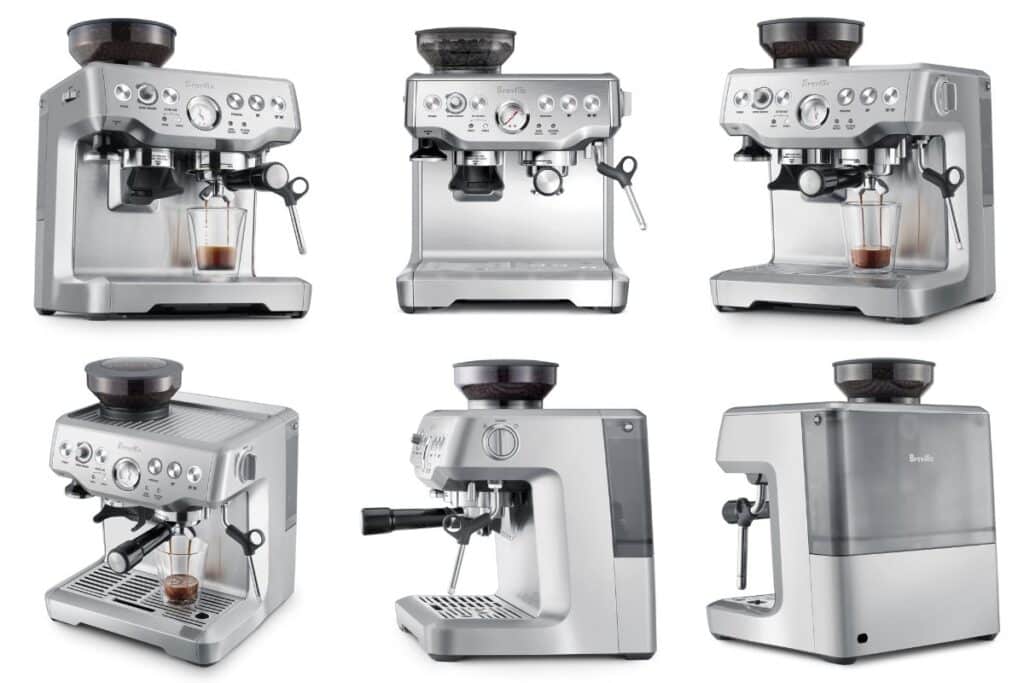
The Breville Barista Express is a highly regarded home espresso machine known for its ability to deliver café-quality espresso. Key features include an integrated conical burr grinder with 16 settings, customizable settings for both beginners and experts, and a professional-grade steam wand for milk frothing. Its brushed stainless steel design is both stylish and durable, fitting comfortably on most kitchen countertops. The machine’s intuitive control panel, pressure gauge, and pre-infusion process ensure consistent, high-quality espresso shots. The PID temperature control maintains precise water temperature, enhancing the flavor and consistency of the espresso.
The Barista Express excels in performance and user experience, quickly heating up and allowing the entire espresso-making process to be completed in under a minute. It accommodates various coffee preferences with adjustable settings for grind size, dose, and water temperature. Regular maintenance is required to keep the machine in optimal condition, including cleaning the portafilter, steam wand, and exterior. Despite its significant upfront investment and regular maintenance needs, the Barista Express is a top contender in the home espresso machine market, offering a compelling blend of performance, convenience, and style for both beginners and experienced baristas.
Best for Beginners
Breville Bambino Plus

The Breville Bambino Plus stands out in the home espresso machine market due to its blend of advanced features, user-friendly design, and affordability. Notable features include the ThermoJet heating system, which reaches optimal extraction temperature in three seconds, and a PID controller for precise temperature control. The machine also boasts an automatic steam wand capable of producing high-quality microfoam, making it accessible for both seasoned baristas and newcomers. Its compact design ensures it fits comfortably in small kitchens without compromising on functionality. However, it requires a separate grinder and frequent emptying, which some may find inconvenient.
In terms of performance, the Bambino Plus excels at producing consistently flavorful espresso with a thick, velvety crema. The machine’s ability to gradually ramp up pressure ensures even saturation of coffee grounds. The automatic steam wand simplifies the process of creating lattes and cappuccinos, although manual swirling of milk might be necessary for perfect foam integration. Maintenance is straightforward with features like a shot counter for deep cleaning reminders and easy-to-remove components. Despite some plastic parts, the machine’s build quality is solid, and it offers excellent value for its price, particularly given the inclusion of accessories like single and double shot baskets, a tamper, and a milk steaming pitcher.
Best with Grinder
Breville Barista Express Impress
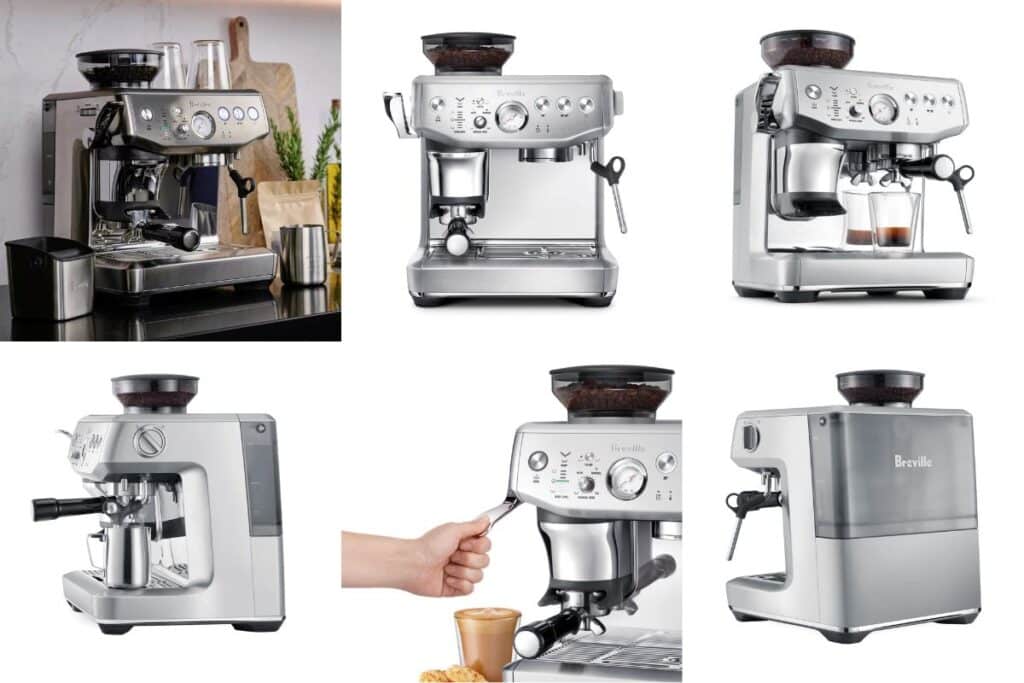
The Breville Barista Express Impress is designed to make home espresso making easier and more accessible, particularly for beginners. It features an integrated grinder with 25 settings, an intelligent dosing system that automatically adjusts the coffee grounds based on previous extractions, and an assisted tamping mechanism that ensures consistent pressure. The steam wand heats up quickly and produces good microfoam, making it ideal for lattes and cappuccinos. The machine is user-friendly with intuitive controls and a digital interface, which guides users through the process, reducing the learning curve associated with making espresso.
Despite its advantages, the Breville Barista Express Impress has some limitations. The grind settings, while adequate for most home users, may not be precise enough for those seeking more control. The automatic volume dispensing can be inconsistent, requiring manual intervention to achieve the desired results. Additionally, the machine needs a short recovery time between shots, which can be inconvenient for heavy users. However, its combination of convenience, consistency, and quality makes it a strong contender for home baristas, offering a blend of automation and user control suitable for both beginners and casual enthusiasts.
Best Budget
Casabrews CM5418 Espresso Machine
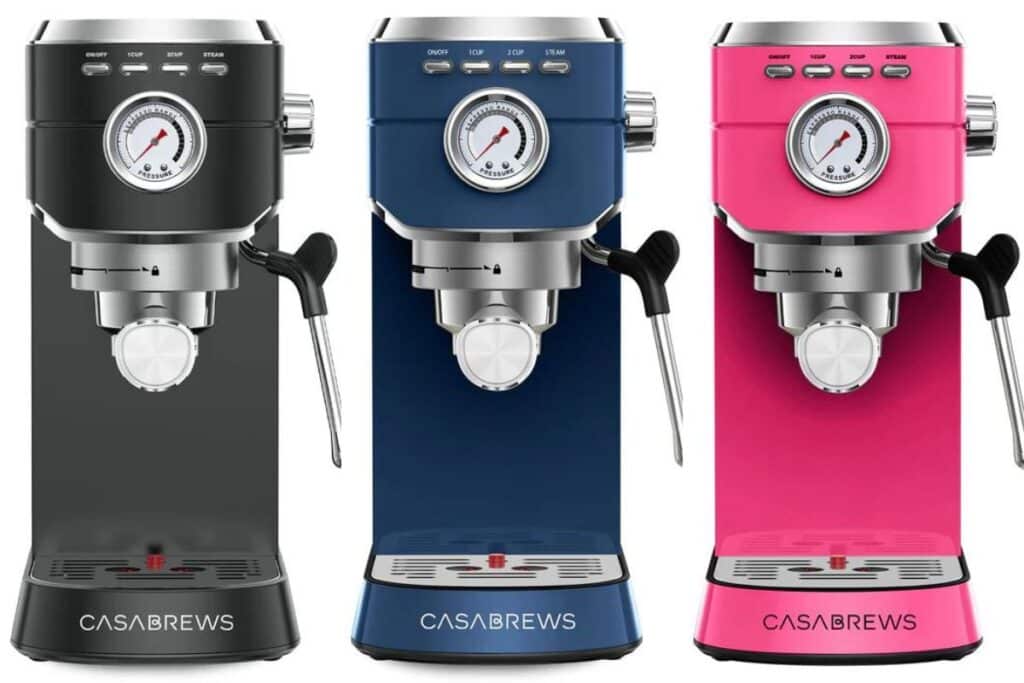
The Casabrews CM5418 Espresso Machine is a budget-friendly option designed for espresso enthusiasts seeking an affordable yet functional machine. Priced at around $140, it is compact and stylish, making it suitable for small kitchens, apartments, and offices. The machine boasts a 20-bar pressure pump, which is essential for extracting rich flavors from coffee grounds. While it performs adequately in brewing hot and flavorful espresso, it falls short compared to higher-end models, particularly in consistency and crema quality. The user interface is simple and intuitive, featuring backlit buttons for power, single or double shots, and steam. The included steam wand produces decent microfoam for milk-based drinks, though it is loud and requires manual effort.
The build quality of the CM5418 is generally solid, with a mix of stainless steel and plastic components to keep costs down. However, some parts like the tamper and portafilter feel less durable. The machine’s temperature control is another area of concern, as the actual espresso temperature is often lower than advertised, which might not satisfy those who prefer their drinks extra hot. Maintenance is straightforward, with removable parts for easy cleaning and detailed descaling instructions provided. Overall, the Casabrews CM5418 offers good value for its price, making it a suitable choice for beginners and casual espresso drinkers, though more serious enthusiasts might want to consider investing in a higher-end model.
Best Compact
KitchenAid Semi-Automatic Espresso Machine
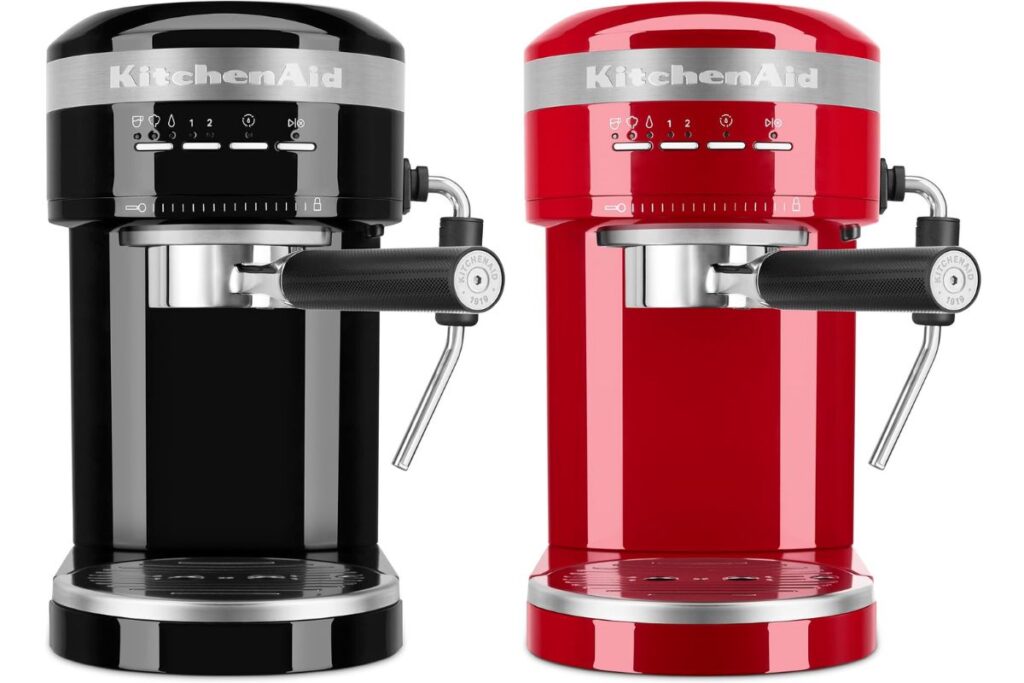
The KitchenAid Semi-Automatic Espresso Machine offers a blend of sleek design and efficient functionality, making it a reliable option for home coffee enthusiasts. Known for its rapid heating through the ThermoCoil system and dual temperature sensors, the machine ensures optimal brewing conditions within 45 seconds. The user-friendly interface, featuring four LED buttons, makes it accessible for beginners, while the commercial-style steam wand allows for versatile milk frothing, essential for creating various coffee drinks. Its durable build, primarily of BPA-free plastic and stainless steel, comes in multiple colors to match any kitchen decor, although the machine’s size may be cumbersome for smaller countertops.
Performance-wise, the KitchenAid Espresso Machine delivers consistent, well-extracted espresso shots with rich crema, thanks to its steady temperature and pressure control. The included accessories, such as the 58mm portafilter and stainless steel milk jug, enhance the overall coffee-making experience. However, the machine does require frequent cleaning due to coffee pooling issues and lacks an integrated grinder, necessitating a separate purchase. Despite these minor drawbacks, its overall functionality, ease of use, and stylish design make it a valuable addition to any kitchen, providing a delightful and consistent coffee experience at home.
Best for Ease of Use
Philips 3200 Series Fully Automatic Espresso Machine
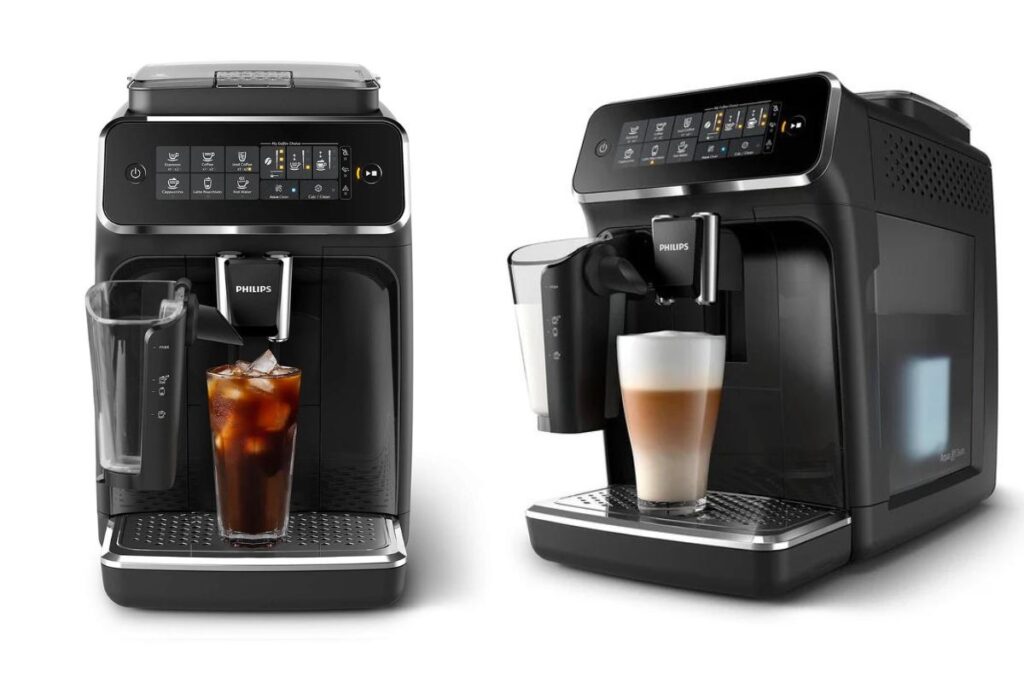
The Philips 3200 Series Fully Automatic Espresso Machine with LatteGo is highlighted for its sleek and modern design, featuring a glossy black finish and chrome-like trim, which saves counter space. The machine’s user-friendly control panel offers one-touch operation for various beverages, including espresso, cappuccino, and Americano, and an innovative LatteGo milk frothing system simplifies the creation of milk-based drinks. It stands out for its ease of setup and use, requiring minimal effort to start brewing. The intuitive interface allows users to brew different coffee drinks effortlessly, making it ideal for both novice coffee enthusiasts and seasoned baristas.
Performance-wise, the Philips 3200 delivers convenience and quality, heating up in roughly one minute and producing flavorful coffee with satisfactory crema. However, some users find the coffee produced weaker than desired, and the LatteGo system’s milk foam is less dense than traditional steam wands. Despite these minor drawbacks, the machine is easy to clean, with removable, dishwasher-safe parts and light-up cleaning indicators. Priced around $775, the Philips 3200 is positioned as a mid-tier espresso machine, offering a compelling combination of convenience, functionality, and quality, making it a worthy investment for elevating home coffee experiences.
Best for Enthusiasts
Rancilio Silvia Espresso Machine

The Rancilio Silvia espresso machine, a single boiler, semi-automatic machine, has been a popular choice among home baristas since its debut in 1997. Known for its robust stainless steel and iron construction, it promises durability and longevity. The Silvia features commercial-grade components like a high-quality portafilter and tamper, enhancing the brewing experience. However, it demands a steep learning curve, requiring precise timing for temperature surfing to achieve consistent brewing temperatures. Despite this, when mastered, it can produce exceptional espresso and high-quality microfoam for lattes and cappuccinos, making it a rewarding choice for dedicated espresso enthusiasts.
One of the unique challenges of the Silvia is its need for temperature surfing due to the lack of a PID controller, which can make maintaining consistent brewing temperatures tricky for beginners. Additionally, the transition between brewing and steaming is cumbersome due to the single boiler design. The machine’s powerful steam wand, capable of producing excellent microfoam, requires practice to master. Regular cleaning and maintenance are essential to maintain performance. While not the most user-friendly, the Silvia is a valuable long-term investment for those passionate about espresso, offering the potential for outstanding results with dedication and practice.
Best Touchscreen
Breville Barista Touch Impress Espresso Machine with Grinder

The Breville Barista Touch Impress is a sophisticated home espresso machine that combines advanced technology with user-friendly features to deliver high-quality coffee-making experiences. Its standout attributes include a touch screen interface that simplifies the brewing process, an Impress Puck System that ensures consistent espresso shots, and a ThermoJet heating system that heats up in just three seconds. Additionally, it offers automatic milk frothing with settings for various milk types, making it easy to create a range of drinks. The machine’s sleek design and durable build quality further enhance its appeal, though its price of $1,500 and limited manual control may be drawbacks for some users.
Compared to other models like the Breville Oracle Touch and the Breville Barista Express Impress, the Barista Touch Impress strikes a balance between automation and user customization. While the Oracle Touch offers more advanced features and manual control at a higher price, the Barista Touch Impress is more compact and accessible, making it suitable for both beginners and experienced users. The Barista Express Impress, on the other hand, is more manual and affordable but lacks the advanced automation and touch screen interface of the Barista Touch Impress. Overall, the Barista Touch Impress is praised for its ability to produce café-quality drinks at home with minimal effort, making it a worthy investment for coffee enthusiasts.
Best Dual Boiler
Breville Dual Boiler Espresso Machine
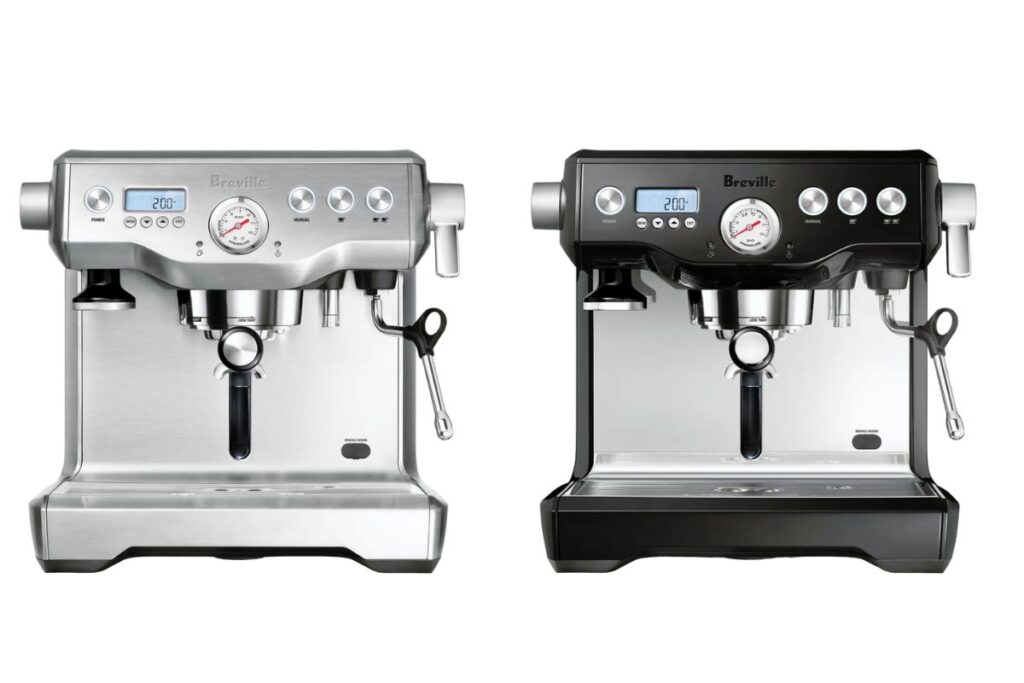
The Breville Dual Boiler is highly regarded among home espresso machines, particularly for those seeking professional-grade quality. The machine features dual stainless steel boilers, allowing simultaneous brewing and steaming, which enhances efficiency and performance. The digital PID control ensures precise temperature management, crucial for consistent and high-quality espresso extraction. Its user interface is designed to be intuitive, catering to both beginners and experienced users, with features like a pressure gauge and volumetric control for customizable shot volumes.
Despite its high price point of around $1,500, the Breville Dual Boiler offers significant value with its robust stainless steel construction, user-friendly design, and high degree of control over the brewing process. The machine’s steam wand is effective for creating microfoam, suitable for latte art, though not as powerful as commercial machines. Maintenance is straightforward, with prompts for cleaning and descaling, ensuring long-term reliability. Overall, the Breville Dual Boiler is a top choice for coffee enthusiasts aiming for a professional espresso experience at home.
Best Dual Boiler with Grinder
Breville Oracle Espresso Machine

The Breville Oracle espresso machine stands out for its ability to combine the convenience of automation with the precision of manual espresso-making, making it ideal for both novices and experienced coffee enthusiasts. Its features include automated grinding, dosing, and tamping, a dual boiler system for simultaneous brewing and steaming, and programmable settings for temperature, shot volume, and milk texture. The machine’s robust stainless steel construction and intuitive digital interface ensure durability and user-friendliness, while its self-cleaning steam wand reduces maintenance efforts. Despite its higher price and large footprint, the Oracle’s capability to deliver consistently high-quality espresso with rich crema makes it a standout choice in the competitive home coffee brewing market.
The Oracle’s design includes three digital displays for grind settings, milk texture, and other settings, providing all necessary information for perfect espresso extraction. Convenience features such as a hidden tools bin, integrated castor system, power cord shortener, and front-filling water reservoir enhance its usability. Performance-wise, the machine excels in coffee quality, speed, and efficiency, allowing for quick preparation and the ability to serve multiple drinks consecutively. Ideal for busy professionals, entertainers, coffee enthusiasts, and beginners, the Oracle offers both automated and manual options to suit varying skill levels. Its ability to deliver high-quality espresso with minimal effort makes it a valuable addition to any kitchen, balancing quality and convenience perfectly.
Final Thoughts
Choosing the right home espresso machine can significantly enhance your coffee experience, providing you with café-quality drinks from the comfort of your own kitchen. This guide has explored a variety of top-performing machines, catering to different needs and skill levels. Whether you are a beginner looking for ease of use or an enthusiast seeking precise control and customization, there’s a machine tailored to meet your requirements. Investing in a quality espresso machine not only elevates your daily coffee ritual but also allows you to experiment and perfect your barista skills. With the right machine, every cup can be a perfect blend of flavor, aroma, and satisfaction.
What to Consider When Buying an Espresso Machine
Purchasing an espresso machine is a significant investment, and choosing the right one can greatly enhance your coffee-making experience. Here are key factors to consider when buying an espresso machine:
1. Types of Espresso Machines
Manual Espresso Machines: These machines require the user to control every step of the process, offering a high level of customization and control. They are perfect for coffee enthusiasts who enjoy the hands-on experience.
Semi-Automatic Espresso Machines: These machines automate some steps of the brewing process, such as maintaining water pressure and temperature, while still allowing for manual control of other variables like grinding and tamping.
Super-Automatic Espresso Machines: These machines handle every aspect of making espresso, from grinding the beans to frothing the milk. They are ideal for those who want convenience and consistency without much effort.
2. Key Features to Look For
Temperature Control: Consistent temperature is crucial for a good espresso shot. Machines with PID (Proportional-Integral-Derivative) controllers offer precise temperature control, ensuring optimal extraction.
Pressure Regulation: The ideal pressure for brewing espresso is around 9 bars. Look for machines that maintain consistent pressure to produce rich, flavorful espresso.
Boiler Type: Machines can have single or dual boilers. Dual boilers allow you to brew espresso and steam milk simultaneously, which is a feature typically found in higher-end machines.
Grinder Quality: The quality of the grinder is just as important as the machine itself. Burr grinders are preferred over blade grinders for their ability to produce a consistent grind size, which is essential for good espresso.
Ease of Use: Features such as programmable settings, user-friendly interfaces, and easy-to-clean components can make the machine more convenient to use daily.
3. Size and Design
Espresso machines come in various sizes and designs. Consider the available counter space in your kitchen and choose a machine that fits well without being cumbersome. Additionally, since the machine will be a visible part of your kitchen, choose a design that you find aesthetically pleasing.
4. Price Range
Espresso machines can range from a few hundred to several thousand dollars. Your budget will significantly influence your options. Generally, higher-priced machines offer better build quality, more features, and greater durability.
- Budget Machines ($200-$500): These can be a good starting point for beginners but might lack some advanced features.
- Mid-Range Machines ($500-$1,500): These offer a balance between performance and cost, providing good quality and more features.
- High-End Machines ($1,500+): These machines are designed for serious coffee enthusiasts, offering professional-level performance and extensive customization options.
5. Brand and Warranty
Reputable brands like Breville, DeLonghi, Rancilio, and Jura are known for their quality and reliability. Additionally, consider the warranty offered by the manufacturer, as it can provide peace of mind and protect your investment.
6. Additional Accessories
To get the best out of your espresso machine, you might need additional accessories such as:
- Tamper: A good tamper ensures that the coffee grounds are evenly compressed.
- Milk Frother: Essential for making cappuccinos and lattes.
- Cleaning Tools: Regular cleaning is vital for maintaining the machine’s performance and longevity.
- Water Filter: Using filtered water can improve the taste of your espresso and prevent mineral buildup in the machine.
Choosing the right espresso machine depends on your budget, the features you value most, and your level of expertise. Whether you’re a beginner or a seasoned barista, investing in a machine that meets your needs can transform your home coffee experience. Take the time to research and consider these factors to find the perfect machine for you.
Frequently Asked Questions (FAQs) about Espresso Machines
How Do You Maintain an Espresso Machine?
Maintaining your espresso machine properly is crucial to ensure it continues to produce high-quality espresso and has a long lifespan. Here are detailed steps for maintaining different parts of your espresso machine:
1. Daily Maintenance
- Purge and Clean the Steam Wand: After every use, purge the steam wand by turning it on briefly to expel any milk residue. Wipe it with a damp cloth to prevent milk from drying and clogging the wand.
- Flush the Group Head: Before and after each espresso shot, run hot water through the group head to remove any coffee grounds and oils.
- Clean the Portafilter and Basket: Remove the portafilter after each use, discard the used coffee grounds, and rinse both the portafilter and the basket with hot water to remove any remaining coffee residue.
- Wipe Down the Machine: Use a damp cloth to wipe down the exterior of the machine, including the drip tray and the control panel, to remove any coffee splashes or milk spills.
2. Weekly Maintenance
- Backflushing:
- What You Need: A blind filter basket (without holes) and espresso machine cleaning detergent.
- How to Backflush: Insert the blind filter basket into the portafilter and add a small amount of cleaning detergent. Lock the portafilter into the group head and run the machine in short intervals (5-10 seconds on, 5-10 seconds off) for several cycles. This process forces the cleaning solution through the group head and into the drip tray, removing built-up oils and coffee residues. Finish by backflushing with clean water to remove any detergent residues.
- Clean the Drip Tray and Water Reservoir: Remove the drip tray and water reservoir, wash them with warm, soapy water, and rinse thoroughly. Make sure they are completely dry before reattaching them to the machine.
3. Monthly Maintenance
- Descaling:
- Why It’s Important: Descaling removes mineral deposits (limescale) that build up inside the machine’s water pathways, which can affect performance and taste.
- How to Descale: Use a commercial descaling solution or a mixture of white vinegar and water. Fill the water reservoir with the descaling solution and run it through the machine as if you were making espresso (without coffee grounds). Let the machine sit for about 20 minutes to allow the solution to work on the deposits, then run clean water through the machine several times to rinse out the descaling solution completely.
4. Milk Frother/Foamer Cleaning
- After Each Use: Immediately after frothing milk, purge the steam wand to clear any remaining milk inside. Wipe the exterior with a damp cloth.
- Deep Cleaning: If your machine has a removable milk frother, disassemble it according to the manufacturer’s instructions and soak the parts in warm, soapy water. Use a small brush to clean inside the frother and rinse thoroughly.
5. Used Coffee Grounds Disposal
- After Each Use: Knock out the used coffee puck from the portafilter into a knock box or compost bin. Rinse the portafilter and basket with hot water.
- Storage: If your machine has an internal container for used coffee grounds, empty it regularly to prevent mold and bacteria growth.
6. Replacing Water Filters
If your espresso machine uses a water filter, replace it according to the manufacturer’s recommendations, typically every 2-3 months. This helps ensure the water used for brewing is free from impurities that can affect the taste of your coffee.
7. General Tips
- Use Fresh, Filtered Water: Always use fresh, filtered water to minimize mineral buildup and improve the taste of your espresso.
- Store Coffee Properly: Keep coffee beans in an airtight container away from heat, light, and moisture to preserve their freshness.
- Regular Inspections: Periodically inspect the gaskets and seals on your machine for wear and tear. Replace them as needed to maintain proper pressure and performance.
By following these maintenance steps regularly, you can keep your espresso machine in excellent working condition, ensuring it continues to produce delicious espresso shots consistently.
What should I look for when buying an espresso machine?
When purchasing an espresso machine, consider the following factors:
- Type of Machine: Choose between manual, semi-automatic, automatic, or capsule machines based on your skill level and convenience preferences.
- Pressure: Look for machines with at least 15-bar pump pressure for optimal espresso extraction.
- Temperature Control: Consistent water temperature is crucial for quality espresso. Machines with PID controllers are highly recommended.
- Milk Frothing: If you enjoy milk-based drinks, ensure the machine has a good steam wand or automatic frother.
- Built-in Grinder: Machines with built-in grinders offer convenience, but standalone grinders often provide more control and quality.
- Ease of Cleaning: Regular maintenance is essential for longevity. Look for machines with easy-to-clean components and automatic cleaning cycles.
How do you clean an espresso machine?
Cleaning an espresso machine involves several steps:
- Daily Cleaning: Purge and wipe the steam wand after each use, flush the group head to remove coffee grounds, and clean the portafilter and basket.
- Weekly Cleaning: Perform a backflush with coffee detergent using a blank filter basket to clean the group head and pressure relief valve.
- Descaling: Monthly or as recommended by the manufacturer, descale the machine to remove mineral buildup, especially if you live in an area with hard water.
- Milk Frother Cleaning: Regularly clean the milk frother to prevent residue buildup and ensure it remains hygienic.
What are the differences between espresso, cappuccino, and latte?
- Espresso: A concentrated shot of coffee made by forcing hot water through finely-ground coffee under high pressure.
- Cappuccino: Typically 5 ounces, made with one-third espresso, one-third steamed milk, and one-third milk foam.
- Latte: Usually 12 ounces, made with one-third espresso and two-thirds steamed milk, topped with a thin layer of milk foam.
Are espresso machines worth the investment?
Investing in an espresso machine offers significant benefits, particularly for coffee enthusiasts who value convenience and customization. Having an espresso machine at home allows you to enjoy your favorite drinks without the need to visit a café, saving both time and money in the long run. The ability to customize your coffee by adjusting grind size, coffee dose, extraction time, and milk froth consistency means you can create the perfect drink tailored to your preferences.
Financially, owning an espresso machine can lead to substantial cost savings. The initial expense of purchasing a high-quality machine may be high, but the long-term savings from making your espresso drinks at home can offset this initial investment. Regularly buying espresso drinks from a café can quickly add up, so making them at home can save a considerable amount of money over time. Additionally, home machines allow you to use freshly ground coffee beans, enhancing the flavor and aroma of your drinks and providing consistent, high-quality results.
Beyond the financial and convenience aspects, owning an espresso machine can also be an enjoyable and rewarding hobby. The process of making espresso—from grinding to tamping to pulling shots—can be satisfying and allows for exploration of different beans, roasts, and brewing techniques. This hands-on approach can deepen your appreciation and understanding of coffee, turning home brewing into a passionate pursuit. While it’s important to consider the costs of maintenance and space requirements, the benefits of owning an espresso machine, such as quality, consistency, and the joy of making your own coffee, can make it a worthwhile investment for those who are passionate about their coffee.
What are the three main types of espresso machines?
Espresso machines can be categorized into three main types: semi-automatic, automatic, and super-automatic. Each type offers different levels of control, convenience, and automation, catering to various user preferences and skill levels. Here’s a detailed look at each type:
1. Semi-Automatic Espresso Machines
Overview: Semi-automatic espresso machines provide a balance between control and convenience. These machines require the user to manually start and stop the espresso extraction process but automate water pressure and temperature control.
Key Features:
- Manual Control: Users must grind, dose, and tamp the coffee, as well as start and stop the shot extraction.
- Pump Pressure: An electric pump ensures consistent pressure, typically around 9 bars, which is ideal for extracting espresso.
- Steam Wand: Most semi-automatic machines include a steam wand for frothing milk, allowing for manual control over the frothing process.
Advantages:
- Control: Users have significant control over the espresso-making process, allowing for fine-tuning and customization.
- Skill Development: Ideal for those who want to learn and master the art of espresso making.
- Quality: Can produce high-quality espresso shots with practice and skill.
Disadvantages:
- Learning Curve: Requires some knowledge and practice to achieve consistent results.
- Time-Consuming: More hands-on, which can be time-consuming compared to more automated options.
2. Automatic Espresso Machines
Overview: Automatic espresso machines, also known as volumetric machines, automate the shot timing process. These machines still require the user to grind, dose, and tamp the coffee, but they automatically stop the extraction once the desired volume of espresso is reached.
Key Features:
- Automatic Shot Timing: The machine uses a pre-programmed volume to determine when to stop the extraction, ensuring consistent shot sizes.
- Pump Pressure: Like semi-automatic machines, they use an electric pump to maintain consistent pressure.
- Steam Wand: Most models include a steam wand for frothing milk, allowing for manual control over milk texture.
Advantages:
- Consistency: Automatic shot timing ensures more consistent espresso shots.
- Convenience: Reduces the need for manual timing, making the process slightly easier.
- Quality: Can produce high-quality espresso with less manual intervention compared to semi-automatic machines.
Disadvantages:
- Less Control: Offers less control over the extraction process compared to semi-automatic machines.
- Learning Curve: Still requires some knowledge and skill for grinding, dosing, and tamping.
3. Super-Automatic Espresso Machines
Overview: Super-automatic espresso machines, also known as bean-to-cup machines, offer the highest level of automation. These machines handle the entire espresso-making process, from grinding the beans to frothing the milk, with minimal user intervention.
Key Features:
- Fully Automated: Grind, dose, tamp, brew, and froth milk with the push of a button.
- Built-In Grinder: Includes a built-in grinder with adjustable settings for grinding coffee beans fresh for each shot.
- Milk Frothing System: Often features an automatic milk frothing system that can produce steamed milk or froth for lattes and cappuccinos.
- Programmable Settings: Allows users to customize and save settings for different types of drinks.
Advantages:
- Convenience: Extremely easy to use, with minimal effort required from the user.
- Consistency: Produces consistent results with every use.
- Speed: Quick and efficient, making it ideal for busy mornings or entertaining guests.
Disadvantages:
- Cost: Typically more expensive than semi-automatic and automatic machines.
- Maintenance: Requires regular cleaning and maintenance, particularly for the milk frothing system.
- Limited Control: Offers less control over the brewing process compared to semi-automatic machines.
Semi-Automatic Espresso Machines offer the most control and are favored by enthusiasts who enjoy the hands-on process of making espresso. Automatic Espresso Machines provide a balance between control and convenience, automating the shot timing while still requiring some manual input. Super-Automatic Espresso Machines are the most convenient, automating the entire process, making them ideal for users who prioritize ease of use and consistency.
Choosing the right type of espresso machine depends on your skill level, desire for control, and how much time you want to spend making your coffee. Each type has its own set of features, advantages, and disadvantages, so consider your preferences and needs before making a decision.
How long do espresso machines typically last?
The lifespan of an espresso machine is influenced by several factors, including the type of machine, build quality, frequency of use, and maintenance practices. Semi-automatic machines, which offer significant user control and fewer automated components, can last 10-15 years or more with proper care. Automatic machines, which automate shot timing but still require manual grinding and tamping, typically last 7-10 years. Super-automatic machines, which handle the entire espresso-making process from grinding to frothing, generally have a lifespan of 5-10 years due to their complexity and the number of components that can wear out.
Build quality plays a significant role in the longevity of an espresso machine. High-end machines made with durable materials like commercial-grade stainless steel and brass tend to last longer. In contrast, budget machines often use more plastic components, which can wear out more quickly. Additionally, the frequency of use impacts lifespan; machines used daily, especially in high volumes, experience more wear and tear, while those used occasionally can last longer.
Regular maintenance is crucial to extending the lifespan of an espresso machine. Daily tasks include cleaning the portafilter and basket, purging the steam wand, and wiping down the machine. Weekly maintenance involves backflushing with cleaning detergent and cleaning the drip tray and water reservoir. Monthly tasks include descaling the machine to remove mineral deposits and deep cleaning the steam wand. Annually, it is essential to inspect and replace worn seals and gaskets and consider professional servicing every 1-2 years.
Signs that it might be time to replace your espresso machine include inconsistent pressure, temperature fluctuations, frequent repairs, and a noticeable decline in espresso quality despite regular maintenance. Addressing these issues promptly and maintaining your machine diligently can ensure it provides delicious espresso for many years.
What accessories are essential for using an espresso machine?
Using an espresso machine effectively requires several essential accessories to ensure high-quality espresso and proper machine maintenance. A good grinder is crucial for achieving the correct grind size, which significantly impacts the extraction process. Burr grinders are preferred for their consistent grind size. A tamper is necessary for evenly compressing coffee grounds in the portafilter, leading to better extraction, while a milk frothing pitcher, ideally made of stainless steel, is essential for steaming and frothing milk for lattes and cappuccinos. Accurate measurement of coffee and water is achieved with a scale, and a knock box provides a convenient way to dispose of used coffee grounds.
Regular cleaning and maintenance are vital for the longevity and performance of an espresso machine. Essential cleaning supplies include backflush detergent for the group head and internal pathways, descaling solution for removing mineral buildup, steam wand cleaner for milk residue, and a group head brush. These tools help keep the machine in top condition and ensure that each espresso shot is of high quality. A distribution tool is useful for ensuring even distribution of coffee grounds in the portafilter, leading to more consistent extractions.
Additional accessories that enhance the espresso-making experience include a thermometer for monitoring milk temperature while frothing, extra filter baskets for switching between shot sizes and types of coffee, and shot glasses or demitasse cups designed to hold the standard espresso shot size. Investing in these accessories not only improves the quality of the espresso but also makes the process more enjoyable and efficient. Regular use of these tools and maintenance practices ensures that the espresso machine operates smoothly and delivers excellent espresso consistently.
What are some common issues with espresso machines and how to troubleshoot them?
Espresso machines, while generally reliable, can encounter common issues such as inconsistent pressure, temperature fluctuations, poor milk frothing, leaks, noisy operation, bitter or sour espresso, and weak or thin crema. Inconsistent pressure can be caused by clogs, a failing pump, or incorrect grind size, while temperature fluctuations may result from a faulty thermostat or heating element. Regular cleaning, descaling, and ensuring proper warm-up time can help mitigate these problems. For poor milk frothing, ensure the steam wand is clean, the steam pressure is adequate, and proper frothing techniques are used.
Leaks often result from damaged gaskets, loose fittings, or cracks in the machine components. Inspecting and replacing worn seals, tightening fittings, and checking for cracks can resolve these issues. Noisy operation might indicate loose components, pump issues, or grinder problems, which can be addressed by securing loose parts, checking the pump, and cleaning the grinder. Bitter or sour espresso typically stems from incorrect grind size, improper extraction time, water temperature issues, or stale coffee beans, requiring adjustments in grind size, extraction time, and ensuring the use of fresh beans.
To ensure your espresso machine continues to produce high-quality espresso, regular maintenance is essential. Clean the machine daily, backflush weekly, and descale monthly to prevent buildup and ensure proper functioning. Address common issues promptly by performing routine inspections, replacing worn parts, and using the correct techniques and ingredients. By maintaining your espresso machine diligently, you can enjoy consistent, high-quality espresso and prolong the machine’s lifespan.

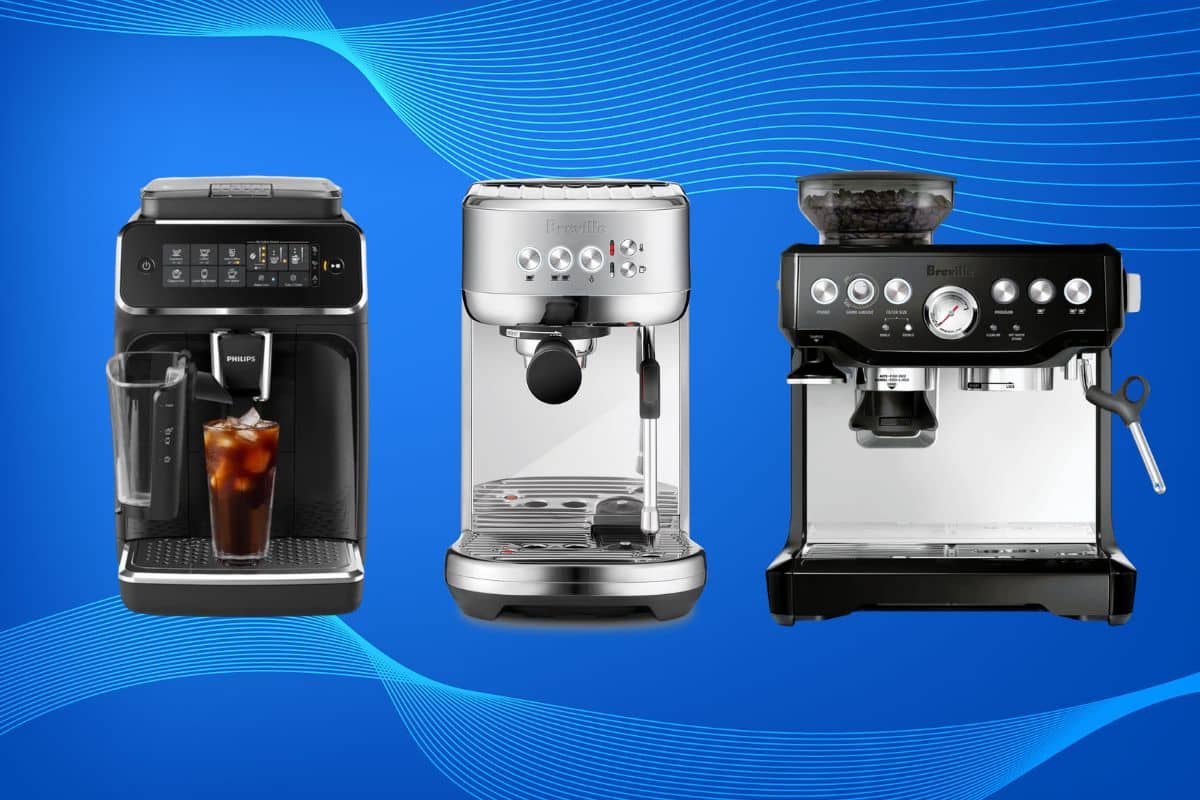
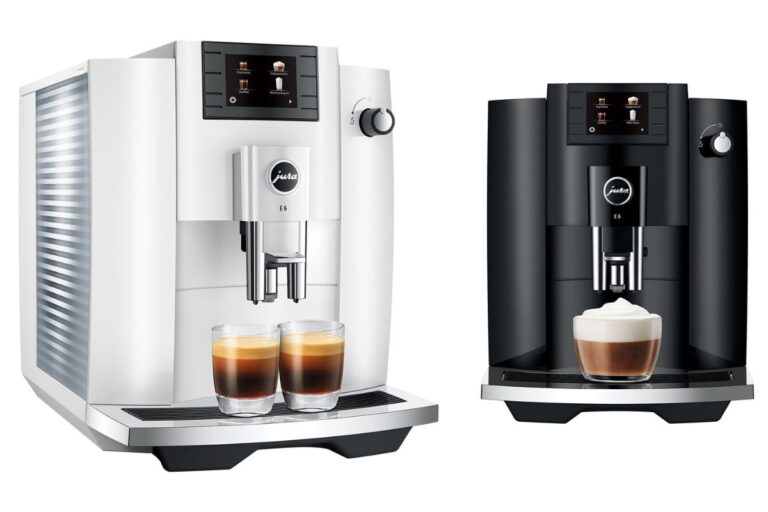
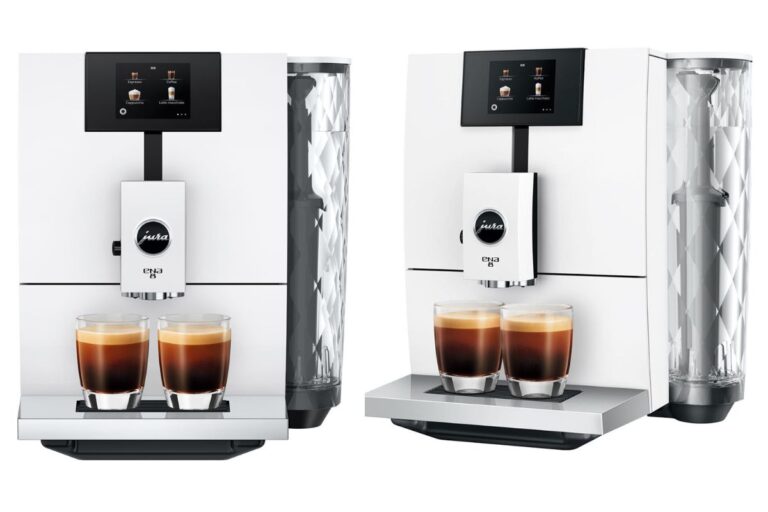
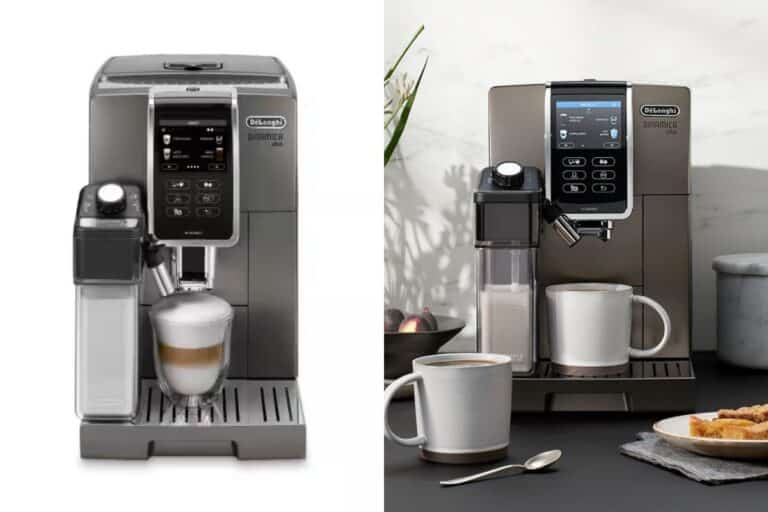
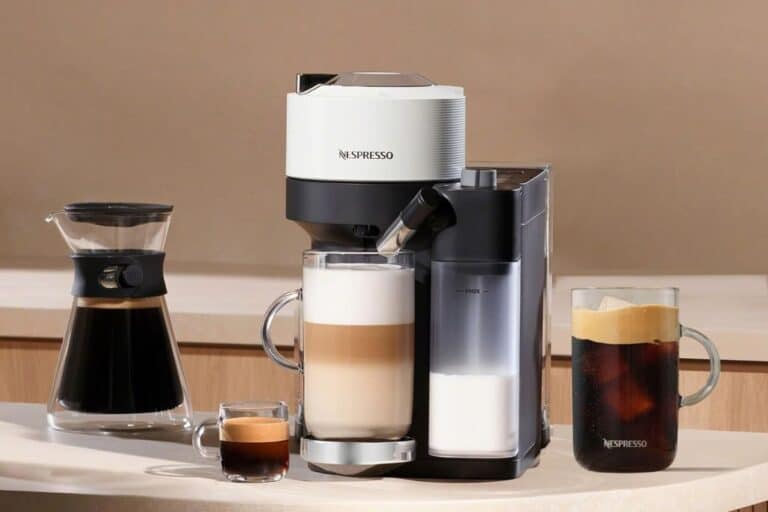
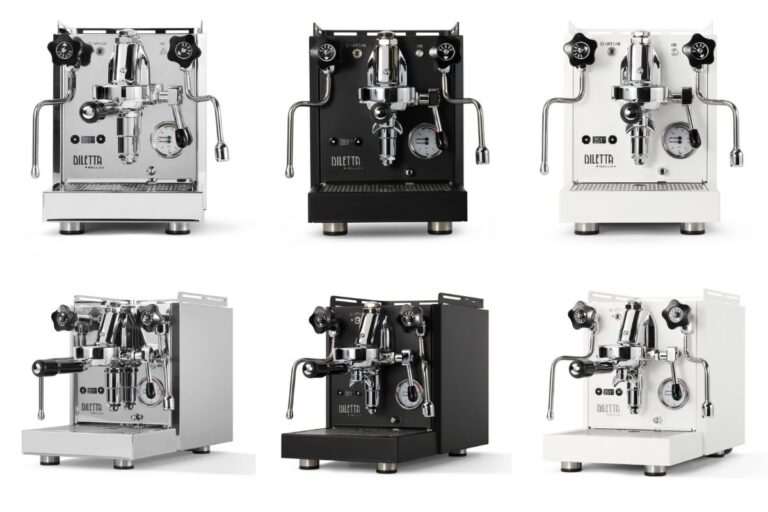
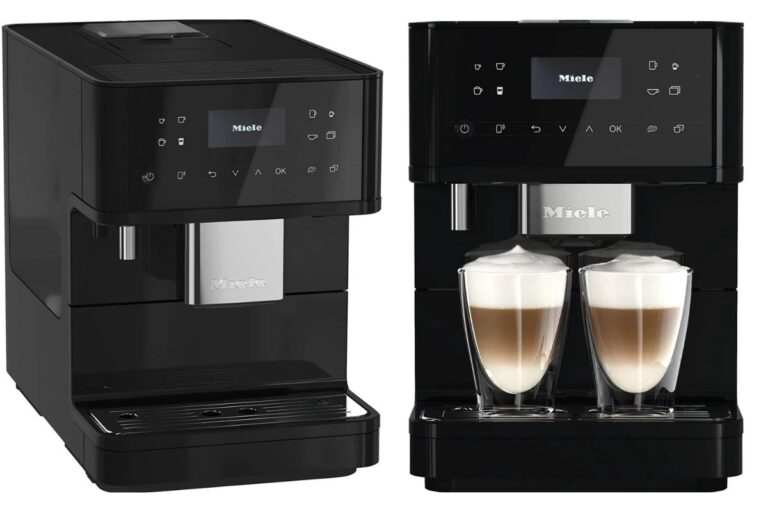


1 thought on “The Best Home Espresso Machines 2025”
What a helpful guide! It really breaks down the options for home espresso machines in a way that makes it easy to figure out what works best for different needs and budgets. I love how it highlights the strengths of each machine, from beginner-friendly options to models for serious coffee enthusiasts. The tips on what to look for when buying and maintaining a machine are super practical too—definitely useful for anyone thinking about upgrading their coffee game at home.